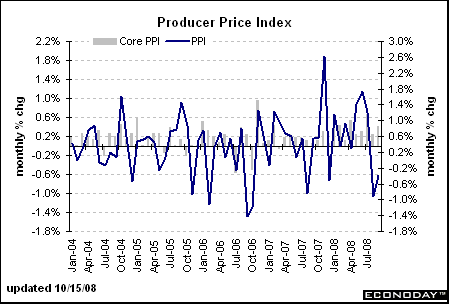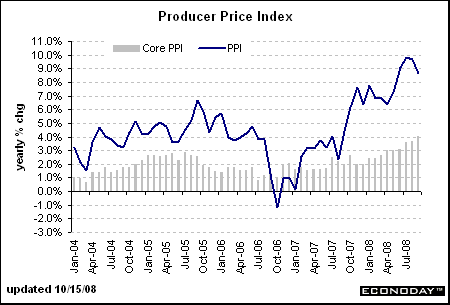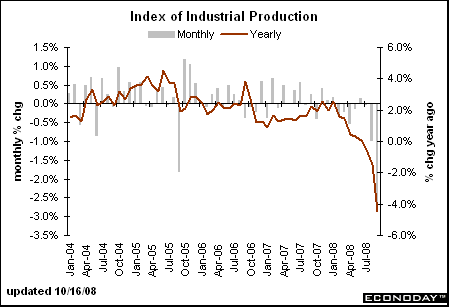(8 am. – promoted by ek hornbeck)

Happy Monday, folks, I do hope you all had a good weekend! Welcome to another installment of Manufacturing Monday! Now things are looking bad out there, as many of you probably already know. We start out with more dire jobs news at GM. Turning to some good news, it seems economic forces that made us “costly” has now turned the tables of sorts, with ironically the biggest pusher of China, Wal-mart (or is it Walmart? I’ve seen this store both ways.) forcing suppliers to look domestically. Lastly, we got Honda moving more work to North America. But first, as is par for the course, we get to the latest economic info related to manufacturing. So without further adieu…
The Numbers!
First on our roster is the Empire State Manufacturing Survey, which is well..a survey of the state’s manufacturers. Each and every month, the New York Federal Reserve conducts a survey of 175 executives of manufacturing companies to see what their take is on business conditions. The survey operates with a scale noting anything above 0.0 is considered “improved conditions.” The survey tends to reflect general conditions for manufacturing in the mid-Atlantic states like Pennsylvania.
The latest Empire survey continued further in its sad dance downwards. The latest figures showing the state of things for October at a minus 24, exceeding the negative 7.4 for the previous month. Despite the recent fall (and somewhat gain) in the US Dollar, manufacturers in the region are finding orders declining. No doubt the current credit crises is also hampering sales, as financing options for purchases are next to nil.

One of the theories I’ve been playing with is that what we are witnessing a 21st century service-economy stagflation. Where in past stagflation periods, we saw supply shocks that resulted in increased cost of goods outpacing the growth in the general economy; for example the oil shocks in the 1970s. In other times, the rate of growth had halted or slowed considerably for income and GDP in general, while the costs associated to materials didn’t recede at the same rate.
Today, though, what we have is a rapid drop in economic output and income, while facing a fluctuating if not volatile rate in material costs. These two factors in our latest version of stagflation are simply by-products of our information age economy, as it is as easy as a push of a button to purchase commodities as it is to sell them. A simple news item, be it a drought or a hiccup in a pipeline, can cause a commodity to suddenly rise or crash. To make matters worse, given the near “drought” conditions for available credit to trading desks, these moves can become rather violent, simply look at the price of crude oil for the past month.
This brings us to our next economic indicator, the Producer Price Index (PPI), a measurement of prices producers of goods or services must face. The latest month-to-month change (including the costs of food and energy) stands at a negative .4%, at consensus of those who watch this, and above the previous month’s minus .9%. Now if one were to exclude food and energy, then we get an entirely different picture, just about the mirror opposite to be exact! Instead, we get an actual increase of .4%, twice the level of consensus and twice that of the previous month.

One can see the volatility in prices, though looking at the harder-to-see gray-shaded core (that excludes food and energy), inflation has been in a positive state. That volatility is mainly a caused by grains and petroleum. Now looking at that chart above, one could conclude that prices have a negative bias, yet I ask you to look at the chart below for a moment.

We’re still in an up trend that began back in 2006. That isn’t to say things could change, and we could enter a downward shift in prices. But I look at the year-over-year change chart (located above) and see that the core PPI hasn’t gone negative in over four years! So, taking a risk here, I am still going to hold on to my theory that inflation is still with us. But what could be hold up PPI? Grains have fallen significantly, and so has metals prices. Copper prices are way below their recent highs (note the chart is too damn big to show on here, so please click on the link). The only thing I can think of is that once again, the rate of growth for material costs has not caught up with the current situation. Despite some cutbacks, manufacturing hubs like China are still growing at 6-8% and are still purchasing needed materials for goods for export.
Inventories, our next economic figure, are showing a positive number meaning a build up. Businesses, in general, need to see inventory be a negative number, highlighting sales and/or increased demand for their product. Of course, that isn’t always the case, as many retailer tend to stock up prior to the holiday shopping season. The Inventory figure, released on the 15th of October, is a lagging indicator reflecting data for August. So think of this as a confirmation of past figures. The recent figure is at .3%, below consensus and way below the previous July figure of 1.1% August was just at the start of the credit crises really reaching the American public, so I would suspect that figures for September and October will show an increase, as consumers start holding back from spending.
We now get to the the other major indicator (outside of that PPI) for manufacturers, Industrial Production! Now actually, this is really two indicators that are published together, along with said indicator we also get Capacity Utilization Rate (CUR), which basically tells us how much of what we can make is actually being used. Well the latest figures, which are for the previous month of September, came in at a negative 2.8%, worse than the previous minus 1.1%, continuing with our theme of declining industrial output. To give you an idea how bad, folks were predicting a half of a percent decline!

But this also correlates with the next number, the Capacity Utilization Rate, which once again fell, now to 76.4%. For the previous month, 78.7% of our nation’s manufacturing capacity was being used.

Sadly, I have a nagging suspicion, that the numbers for October will be equally bad, if not worse.
GM and 1,600 workers
After reading the above, it comes no surprise to hear about further layoffs from our ailing auto companies. Heck, perhaps the tragedy that is GM and Ford or Chrysler probably is adding to this sad story, like another murder victim in a crime mystery. Faced with declining sales, unfortunately the hard working folks at three plants are now forced to participate in this sorry state of affairs in the worst way.
DETROIT – Another 1,600 workers at three General Motors Corp. factories will be laid off indefinitely over the next few months as the company tries to control its inventory amid a worsening U.S. sales slump.
About 700 workers at GM’s pickup truck plant in Pontiac will be furloughed starting Feb. 1, while another 500 at the Detroit-Hamtramck sedan factory will be laid off starting Jan. 12, spokesman Chris Lee said Thursday. In addition, 400 workers at a two-seat sports car assembly plant in Wilmington, Del., also will be out of work starting Dec. 8.
– excerpt from “GM to lay off 1,600 workers at 3 factories“, AP, 2008.
The closures cut across almost all the product lines. From the Sierra pickups and Chevy Silverados in the Pontiac plant, to the Cadillac sedans at the Detroit area factory, to the one in Wilmington making Opel’s GT roadsters. According to the article, the auto “giant” still had inventory to sell and did not see any increase in orders. Most of these places had already been stripped down to a single operating shift. But folks at GM says that they anticipate further sales slump in these lines, particularly the trucks.
The cuts were only the beginning, as the article and another few sources are now saying that more is on the way. Many of the in-house supply shops will be eliminated. Adding to this employment pogrom would be the redundancies found in a potential merger between General Motors and Chrysler. Talks were held then stalled then resumed this past week. GM also has approached Ford, in the end what we could be seeing is the mother of all consolidations in the domestic auto industry. This time next year, we could be facing one single US-based automobile maker, folks.
Well, yes, I grant you, there are start ups. But none of these young turks are in any position to take on Toyota or Honda or hell…not even KIA! It isn’t just GM shedding jobs. Tesla Motors recently notified it’s Detroit workers, that they were getting 86’ed, some found out in a very uncool way I might add!
Man, it just pains me to see folks get laid off, sure the company’s losing money and needs to cut costs. But my stars, this time of year? To say they’re gonna have a miserable holiday season is putting it mildly. What a contrast to what’s going on with the US-side of the Japanese automakers.
Now I understand, folks don’t like bailouts, and neither do I. Perhaps this may be one of those industries that the government simply has to take over or have a very major hand in. To cede this industry to say Japan, would be in my opinion, a similar crime to how we allowed our electronics industry to disappear. In Japan, well actually Korea as well, government there had a hand in fostering those industries. Why? Because they wanted the jobs. And that, my friends, is something we ought to think about.
Alabama bags some jobs from the Dragon, beware of Walmart though!
Walmart, when I think of them, the words “Faustian deal” come to mind. On one hand they will sell you a product at a very affordable price. Yet, and here comes the rub, it actually comes at a higher economic price. Yes, you’ll save 10% on those Huggies or pair of shoes, but someone is being underemployed and not getting proper health insurance; and that’s only the beginning! Walmart has driven small town commercial districts into oblivion and pushed suppliers to get on the cost arbitrage game just to keep the account. For the most part, that latter has had to forsake hiring in the US or Canada to keep costs down (and profits up) to compete with other suppliers to the Arkansas retail behemoth by setting up operations in Asia or Latin America.
Yet now, the quest for ever lower cost of goods has taken an interesting turn. For the first time in a long long while, it now seems this side of the Pacific has the cost advantage. Decades of cost cutting and recent rise in shipping costs and fall in the US Dollar has caught the attention of Walmart.
Oct. 14 (Bloomberg) — Wal-Mart Stores Inc.’s worldwide quest for a lower-cost sleeping bag has led to a one-story factory in northwest Alabama, where Chris Defoor has a new job.
The same forces that have sent thousands of American jobs overseas are now giving a lift to places like Haleyville, a town of 4,200 where Defoor is in his fourth month working at Exxel Outdoors Inc.
With costs in Alabama running 3 percent below those in China, Exxel is cutting production at a joint venture in Shanghai while hiring workers, adding machines and increasing output at the 250,000 square-foot plant. This year, for the first time, the company will make more bags in the U.S. than abroad.
– excerpt from “China Loss Is Alabama Gain“, Bloomberg, 2008.
Walmart’s still on my crapper list for companies, but like with Japanese car companies setting up shop here, I also smile when someone over here grabs a job from over there. Yes, that may sound callous, what about the poor sod in those heavily populated urban areas that needs to send a remittance back to his family? Don’t they need cash to live beyond what sustenance farming provides? Yes…yes they do, but do they think about the union family in Dayton or that single mother in Alabama who just saw their manufacturing job shipped to China or Vietnam? Both families are unfortunately caught up in the tactics of wage arbitrage in the larger game of global trade. It is what it is, and frankly while I can sympathize for the needs of those in the developing world, I see folks over here struggling and losing everything they have. Kudlowites may claim that free-trade is not a zero-sum game, but so far the opposite has been true.
Now we have this piece about a sleeping bag manufacturer expanding in Alabama. He could have also set up shop in mainland China or Vietnam, but chances are that in 5-10 years time, either the government folks that helped establish a factory or the outfit he contracted with to do the manufacturing would soon be competing with him. It has happened time and time again, how do you think companies like Haier got started?
Honestly, I don’t know how long companies like Exxel Outdoors can go on, if the US Dollar should return to a more bullish stance against the Renmimbi. I wish them well, and hope that their deal with Walmart goes on longer. But I don’t trust Walmart, they will eventually force this company to lower their prices even further beyond costs, forcing Exxel to restructure. This happened with Vlasic Pickle, I remember reading a story on them where they did a deal with Walmart that almost bankrupted them. Wait…in fact let me get you that story! Below is an excerpt, I highly recommend you read the whole thing though.
Wal-Mart priced it at $2.97–a year’s supply of pickles for less than $3! “They were using it as a ‘statement’ item,” says Pat Hunn, who calls himself the “mad scientist” of Vlasic’s gallon jar. “Wal-Mart was putting it before consumers, saying, This represents what Wal-Mart’s about. You can buy a stinkin’ gallon of pickles for $2.97. And it’s the nation’s number-one brand.”
Therein lies the basic conundrum of doing business with the world’s largest retailer. By selling a gallon of kosher dills for less than most grocers sell a quart, Wal-Mart may have provided a ser-vice for its customers. But what did it do for Vlasic? The pickle maker had spent decades convincing customers that they should pay a premium for its brand. Now Wal-Mart was practically giving them away. And the fevered buying spree that resulted distorted every aspect of Vlasic’s operations, from farm field to factory to financial statement.
– excerpt from “The Wal-Mart You Don’t Know“, Fast Company.com, 2003.
Don’t get me wrong, I am happy to hear Exxel score one against a foreign competitor. I just hope they know what’s coming at them down the road.
Honda to US: Hey..come on over, the job pool is warm!
While our domestic automakers are shedding jobs, the Japanese are increasing their investment in America. Honda has said that they are focusing their manufacturing capabilities here to meet future demand for fuel-efficient cars. The Japanese auto giant will be shifting work around in it’s US-based operations.
Plants in question are in Lincoln, Alabama and in Marysville, Ohio. The Lincoln plant will get the Marysville assignment on the V-6 Accord, while the Ohio plant will then shift to the four cylinder versions. A second Ohio plant, recently completing a $138 million dollar expansion, will also focus on the four cylinder engines.
“We are leveraging our flexible manufacturing network to meet the needs of our customers for more fuel-efficient products,” John Mendel, American Honda Motor Co.’s executive vice president, said in a release. “We will continue to guide our business based on strategic and careful management tied to our core values.”
While day-to-day operations at the three facilities will be different, production capacity or volume at each plant won’t change, Honda said.
– excerpt from “Honda shifting some US manufacturing ops.“, Bizjournal.com, 2008.
Following the recent years of industrial decline in Ohio, I’m happy to hear that these areas are seeing more work come to them. Yes, it is from a foreign company, but our own motor companies sure as hell ain’t expanding. This comes on the heel of Toyota announcing that they were setting up manufacturing operations for the Prius. Wouldn’t it be something, if we started exporting cars (albeit Japanese-branded ones) to Japan to the point we had a surplus with them?
Cross posted on The Economic Populist and Venomopolis.

1 comments
Author
Hey gang, beginning of the week, another chance to kick cheating Republican ass! First off though, let me say thanks for taking the time for reading my latest entry, it means a lot as always. I look forward from hearing from you. Now, once more…let’s go show those supply-siders a thing or two!